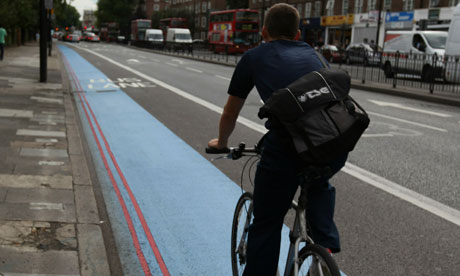
Cyclists in London could be given a headstart at traffic lights on particularly busy junctions under a review into how to cut the toll of cycling deaths and injuries in the capital.
Transport for London (TfL) is to examine more than 500 junctions to see how they can be made more safe for cyclists. Last year 16 cyclists died in London, including two within three weeks at one junction, Bow roundabout, in the east of the city.
The roundabout is part of a system of so-called cycle superhighways, designated routes marked by a blue-painted lane. Critics say these give a false sense of security since the lanes are not separated by kerbs and regularly cross busy junctions.
The TfL review will involve all 375 junctions on the cycle superhighways, as well as 150 others picked for reasons including high rates of bike collisions.
The proposed redesign at Bow is likely to include the installation of traffic lights set with an "early start" phase for cyclists, allowing them to move ahead of the mass of motor traffic. This would be an option at other junctions, a TfL spokeswoman said.
"When they are reviewing other junctions they will be looking at all aspects, and what would work best for that junction. The early start for cyclists would be considered as part of this, but this doesn't mean they will all have it. Each junction will be reviewed independently," the spokeswoman said.
Cycle safety has become an increasingly high-profile issue nationally, with campaigners warning that decades of safety gains risk being eroded. Government statistics show that last year the number of deaths and serious injuries fell for all types of road user except cyclists.
The issue is particularly acute in London, where cycling levels are rising by an estimated 10% a year and there has been a series of high-profile cases of cyclists being crushed by lorries turning left at junctions.
TfL and the mayor, Boris Johnson, who has ultimate say over transport strategy, have faced criticism in recent months over what campaigners see as an emphasis on keeping motorised traffic flowing at the expense of safety for cyclists and pedestrians. Johnson said the junction review marked a new start: "We are seeing a step-change in both the way that people choose to travel, but also in the way that cyclists are viewed on our streets."
Ashok Sinha, chief executive of the London Cycling Campaign, said he gave a "qualified welcome" to the planned change to traffic lights.
He said: "These things are always about the detail. How is it going to work? Are the traffic signal phasings going to give cyclists the kind of priority they will need to get across the junction safely? Or are they going to be set at a level which will frustrate regular cyclists who will end up joining the general traffic rather than being held up twice?"
Ultimately, Sinha said, the road system needed a fundamental rethink: "It's not about cars v people. It's about a people-oriented city, a more liveable city, where you can cycle and walk in safety, where your kids can play out on the streets in safety, with proper provision for the movement of public transport and motor vehicles."

